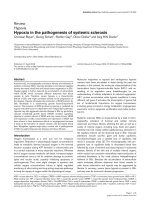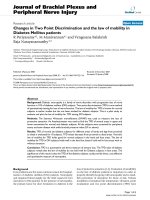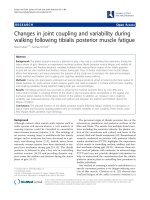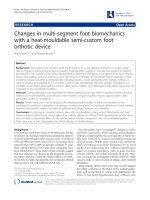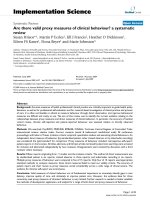Báo cáo y học: "Changes in serum adiponectin concentrations in critical illness: a preliminary investigation" ppt
Bạn đang xem bản rút gọn của tài liệu. Xem và tải ngay bản đầy đủ của tài liệu tại đây (106.45 KB, 5 trang )
Open Access
Available online />Page 1 of 5
(page number not for citation purposes)
Vol 13 No 4
Research
Changes in serum adiponectin concentrations in critical illness: a
preliminary investigation
Bala Venkatesh
1
, Ingrid Hickman
2
, Janelle Nisbet
2
, Jeremy Cohen
3
and John Prins
2
1
Department of Intensive Care, Princess Alexandra & Wesley Hospitals, University of Queensland, Ipswich Road, QLD 4102, Woolloongabba,
Australia
2
Department of Endocrinology, Princess Alexandra Hospital, University of Queensland, Ipswich Road, QLD 4102, Woolloongabba, Australia
3
Department of Intensive Care, Royal Brisbane Hospital, University of Queensland, Butterfield Street, Herston Road, Herston, QLD 4029, Brisbane,
Australia
Corresponding author: Bala Venkatesh,
Received: 24 Apr 2009 Revisions requested: 15 May 2009 Revisions received: 8 Jun 2009 Accepted: 2 Jul 2009 Published: 2 Jul 2009
Critical Care 2009, 13:R105 (doi:10.1186/cc7941)
This article is online at: />© 2009 Venkatesh et al.; licensee BioMed Central Ltd.
This is an open access article distributed under the terms of the Creative Commons Attribution License ( />),
which permits unrestricted use, distribution, and reproduction in any medium, provided the original work is properly cited.
Abstract
Introduction Adiponectin plays an important role in the
regulation of tissue inflammation and insulin sensitivity.
Perturbations in adiponectin concentration have been
associated with obesity and the metabolic syndrome. Data on
adiponectin pathophysiology in critical illness are limited.
Methods Twenty three critically ill patients (9 severe sepsis, 7
burns, 7 trauma). Adiponectin assays on Days 3 (D3) and 7
(D7). Simultaneous, cortisol, cortisone and CRP measurements.
Data from 16 historical controls were used for comparison.
Results The mean plasma adiponectin concentration for the
ICU cohort on D3 and D7 were not significantly different (4.1 ±
1.8 and 5.0 ± 3.3 mcg/ml respectively, P = 0.38). However,
these were significantly lower than the mean plasma adiponectin
in the control population (8.78 ± 3.81 mcg/ml) at D3 (P <
0.0001) and D7 (P = 0.002). Plasma adiponectin showed a
strong correlation with plasma cortisol in the ICU group on both
D3 (R
2
= 0.32, P < 0.01) and D7 (R
2
= 0.64, 0.001). There was
an inverse correlation between plasma adiponectin and CRP on
D7, R = -0.35.
Conclusions In this preliminary study, critical illness was
associated with lower adiponectin concentrations as compared
with controls. A significant relationship between plasma cortisol
and adiponectin in critically ill patients was evident, both during
the early and late phases. These data raise the possibility that
adiponectin may play a part in the inflammatory response in
patients with severe illness.
Introduction
Adiponectin, a hormone secreted exclusively by adipose tis-
sue, plays an important role in the regulation of tissue inflam-
mation and insulin sensitivity [1]. Perturbations in circulating
adiponectin concentrations are associated with the metabolic
syndrome, altered inflammatory response and insulin resist-
ance [2]. Hypoadiponectaemia is also associated with
impaired endothelium-dependent vasorelaxation [3]. Although
several of the above features are also evident in human critical
illness, the underlying mechanisms are not fully understood.
Some of these manifestations have been attributed to
changes in plasma cortisol profile.
Data in patients with viral infections and human experimental
endotoxaemia suggest altered release patterns of adiponectin
in these states [4,5]. However, there are no published data on
circulating serum adiponectin concentrations in human septic
shock and critical illness. We therefore utilised available sam-
ples from a previously undertaken study of critically ill patients
to examine serial changes in serum adiponectin concentration
in a heterogeneous cohort of critically ill patients (sepsis,
trauma and burns), determine the relation between the inflam-
matory response and adiponectin concentrations, and evalu-
ate the correlation between plasma cortisol and adiponectin
concentrations.
APACHE: Acute Physiology and Chronic Health Evaluation; BMI: body mass index; CRP: C-reactive protein; CV: coefficient of variation; D3: day 3;
D7: day 7; SAPS: simplified acute physiology score; TNF: tumour necrosis factor.
Critical Care Vol 13 No 4 Venkatesh et al.
Page 2 of 5
(page number not for citation purposes)
Materials and methods
The plasma samples for this study were obtained from our pre-
viously published study investigating plasma cortisol-cortisone
ratios in 52 critically ill patients comprising of three cohorts –
burns, trauma and sepsis [6]. Residual plasma samples for adi-
ponectin analysis were only available in 23 of these patients
(nine sepsis, seven trauma, seven burns; age range 26 to 65
years; 21 males and 2 females), which were used in the
present study. An independent ethics committee approval was
obtained from the Royal Brisbane Hospital Ethics Committee
for this study and reporting of data. The original samples were
collected after informed consent from either patients or their
next of kin. The other measurements on the same samples
from these patients performed in the original study (cortisol,
cortisone and C-reactive protein (CRP)) were used for correl-
ative analysis.
A detailed description of inclusion and exclusion criteria was
provided in the original paper. Briefly, patients with septic
shock (as defined in Consensus Criteria), burns of more than
30%, and blunt or penetrating trauma of at least two body
regions requiring admission to the critical care unit were
enrolled in the study.
Patients younger than 16 years of age, those with a previous
history of adrenal or pituitary disease, prolonged use of oral or
inhaled glucocorticoids or current therapy with any such
agents were excluded. The care of the patients was as per
standard practice. No patient received intravenous or oral glu-
cocorticoids.
In the original study, blood samples were collected for analysis
of cortisone, cortisol and CRP daily for the first five days and
on days 7, 10, 15 and 28. Residual sera were stored in a
freezer at -20°C. As the predominant number of residual sam-
ples, was available only on day 3 (D3) and D7, these samples
were used for the adiponectin assay.
Biochemical measurements
Total serum adiponectin was measured using human adi-
ponectin radioimmunoassay (Linco Research, St Charles, MI,
USA; coefficients of variation (CV) for the assay <10%). Cor-
tisol and cortisone were measured by high performance liquid
chromatography. The CV at cortisol levels of 23 nmol/l and
1006 nmol/l were 6.5% and 2.4%, respectively, and for corti-
sone at concentrations of 110 nmol/l and 1026 nmol/L were
10.9% and 9.2%, respectively. CRP (standard assay) was
assayed using an immunoturbimetric assay (Roche Diagnos-
tics, Sydney, Australia). Interassay CV at 13 mg/L was 4.5%.
Statistical analysis
The means and standard deviations for normals obtained from
population values from our laboratory (see Results section)
were used to compare the patient populations. Continuous,
normally distributed variables were summarised as mean ±
standard deviation. Changes in plasma adiponectin between
D3 and D7 were compared using an unpaired T-test assuming
unequal variances. The degree of association between varia-
bles (adiponectin and cortisol, cortisone, CRP and cortisol/
cortisone ratio) and skewed or ordinal outcome measures
(such as Acute Physiology and Chronic Health Evaluation
(APACHE) and simplified acute physiology score (SAPS))
was assessed using Spearman's correlation coefficient (r
s
).
Statistical significance was taken at a level of 5%.
Results
The demographic profile, the diagnostic categories and the
plasma endocrine profile of the patients are presented in Table
1.
Plasma adiponectin profiles
The mean plasma adiponectin concentration for the whole
cohort on D3 and D7 were 4.1 ± 1.8 and 5.0 ± 3.3 mcg/ml,
respectively (P = 0.38). The mean plasma total adiponectin in
the control population (16 historical controls; 12 males, 4
females, mean age 38.9 ± 8.7 years) was 8.78 ± 3.81 mcg/
ml, significantly higher than the total intensive care group at D3
(P < 0.0001) and D7 (P = 0.002).
Plasma cortisol and cortisone profile
There were no differences in plasma cortisol (418 ± 512 vs
441 ± 362 nmol/L, P = 0.91) or plasma cortisone (31 ± 18 vs
22 ± 11 nmol/L, P = 0.06) between D3 and D7, respectively.
Relation between plasma adiponectin vs inflammatory
markers
There was a poor correlation between plasma adiponectin and
CRP on D3; however, on D7 an inverse correlation was noted,
R = -0.35 (Figure 1).
Relation between plasma adiponectin and sickness
severity
There was a trend towards a relation between APACHE II
scores and plasma adiponectin on D3 (R = 0.4, P = 0.07), but
not on D7 (R = 0.17, P = 0.48).
Relation between plasma adiponectin and cortisol and
cortisone
For correlative analysis, missing results were removed and
only those with matching adiponectin and adrenal hormonal
data were included. Plasma adiponectin showed a strong cor-
relation with plasma cortisol in the group as a whole on D3 (R
2
= 0.32, P = 0.01) and D7 (R
2
= 0.64, P = 0.0001).
Discussion
To the best of our knowledge this is the first report of plasma
adiponectin profiles in a heterogeneous cohort of critically ill
patients. In this study, we have demonstrated a lower plasma
adiponectin concentration as compared with historical con-
trols and a strong association between plasma cortisol and
Available online />Page 3 of 5
(page number not for citation purposes)
adiponectin. This is notable because plasma cortisol concen-
trations vary widely in critically ill adults owing to the heteroge-
neity of the stress response. A trend towards an inverse
relation between the inflammatory response and adiponectin,
and a linear response between sickness severity and plasma
adiponectin was also observed.
The mechanism behind the reduction in plasma adiponectin
was not investigated in this study. However, it is well recog-
nised that glucocorticoids, inflammation and oxidative stress
(commonly associated with critical illness) are known to
decrease adiponectin production [7]. This pattern is also con-
sistent with what has been observed in rodent models of sep-
sis [8]. A significant positive relation between plasma cortisol
and adiponectin has been previously shown in healthy volun-
teers [9,10], particularly in males [10]. In our cohort, more than
90% were males, and this strong association was evident
even in critical illness in our study in both the early and late
phases. A possible mechanism for the relation between corti-
sol and adiponectin could be that the promoter region for the
adiponectin gene contains consensus sequences for gluco-
corticoid receptor binding [11]. The inverse association
between adiponectin and CRP (R = -0.35) in our study is con-
sistent with what has been reported in patients with coronary
artery disease [12].
Significance in critical illness
As adiponectin plays an important role in tissue inflammation,
endothelial function and vascular reactivity, this could repre-
sent a key pathway in determining steroid and inotrope
responsiveness in septic shock. Adiponectin, through its neg-
ative feedback effects on TNF-alpha [13], may be a critical
Table 1
Demographic, diagnostic, sickness severity and endocrine profiles of the study group
Category APACHE Hospital
survival
D3
Adiponectin
D3
Cortisone
D3
Cortisol
D3
CRP
D7
Adiponectin
D7
Cortisone
D7
Cortisol
D7
CRP
Sepsis 10 Survived 4.7 24 238 187 4.6 33 321 146
Sepsis 16 Survived 1.6 34 331 223 3.1 33 413 85
Sepsis 22 Survived 4.4 26 462 286 7.4 24 490 301
Sepsis 8 Survived 4.4 19 97 147 2.6 31 444 403
Sepsis 19 Survived 1.0 23 288 265 2.4 31 325 204
Sepsis 28 Survived 2.4 N/A N/A 447 3.4 13 323 266
Sepsis 24 Survived 5.1 21 173 202 8.9 23 998 94
Sepsis 14 Died 4.4 14 451 264 3.3 13 230 166
Sepsis 13 Survived 8.3 93 2620 278 14.3 35 1770 166
Trauma 12 Survived 2.9 17 371 347 3.6 12 336 184
Trauma 19 Survived N/A 32 159 109 3.1 28 352 N/A
Trauma 15 Survived 4.7 36 162 266 N/A 2 463 76
Trauma 12 Survived 3.5 50 379 224 5.6 4 83 178
Trauma 12 Survived 6.0 62 681 N/A 7.0 14 517 76
Trauma 10 Survived 7.4 11 264 324 2.3 N/A N/A 564
Trauma 18 Survived 4.8 42 588 258 N/A N/A N/A N/A
Burns 15 Unknown 4.2 22 180 N/A N/A N/A N/A N/A
Burns 7 Survived N/A 13 364 N/A 9.1 36 279 154
Burns 16 Survived 2.8 36 368 218 N/A 25 372 410
Burns 19 Unknown 4.0 28 135 104 3.0 17 217 198
Burns 17 Survived 3.2 26 262 202 5.3 35 411 376
Burns 25 Survived N/A 34 311 241 2.8 17 197 251
Burns 24 Died 2.8 27 322 144 2.7 16 283 228
Cortisol and Cortisone expressed in nmol/.
Adiponectin expressed in mcg/ml.
APACHE = Acute Physiology and Chronic Health Evaluation; CRP = C-reactive protein; N/A = not available.
Critical Care Vol 13 No 4 Venkatesh et al.
Page 4 of 5
(page number not for citation purposes)
determinant of the severity of the inflammatory response and
multiple organ dysfunction. In animal models of sepsis, adi-
ponectin modulates inflammation and survival [14]. However,
its role in human critical illness needs to be evaluated further.
Limitations
This is a preliminary study limited by a small sample size. Adi-
ponectin analyses were performed on residual sera from our
previous study [6] and historical controls were used. Compar-
isons between D3 and D7 are partly limited because paired
samples were not available in every patient. As body mass
index (BMI) is known to be associated with plasma adiponec-
tin, a correlation between the BMI of patients and adiponectin
would have provided additional useful information; however,
as body weights are not routinely measured in critically ill
patients, this analysis was not possible. Despite these limita-
tions, the data from this study are in keeping with similar
plasma profiles of adiponectin in human volunteers adminis-
tered endotoxin [5]. Moreover, the results from D3 and D7 are
relevant as patients would have completed their resuscitation
phase and therefore large fluid shifts are less likely in this stage
to have an impact on plasma concentrations.
Conclusions
In conclusion, in this preliminary study, we have demonstrated
a significant relation between plasma cortisol and adiponectin
in critically ill patients, both during the early and late phases.
Overall, these data raise the possibility that adiponectin may
play a part in the inflammatory response in patients with severe
illness. These results are preliminary and hypothesis generat-
ing. The relation between adiponectin and the inflammatory
response, organ dysfunction and outcome in critical illness
should be the subject of future investigations.
Competing interests
The authors declare that they have no competing interests.
Authors' contributions
BV: Study design, analysis of data and manuscript prepara-
tion. IH: Adiponectin data analysis and manuscript review. JN:
Adiponectin data analysis and manuscript review. JC: Cortisol
and adiponectin analysis and manuscript review. JP: Study
design, analysis of data and manuscript preparation.
References
1. Whitehead JP, Richards AA, Hickman IJ, Macdonald GA, Prins JP:
Adiponectin – a key adipokine in the metabolic syndrome. Dia-
betes Obes Metab 2006, 8:264-280.
2. Hickman IJ, Whitehead JP, Prins JP, Macdonald GA: Raised
alanine transaminase and decreased adiponectin are features
of the metabolic syndrome in patients with type 2 diabetes.
Diabetes Obes Metab 2007, 9:438-440.
3. Ouchi N, Ohishi M, Kihara S, Funahashi T, Nakamura T, Nagaretani
H, Kumada M, Ohashi K, Okamoto Y, Nishizawa H, Kishida K,
Maeda N, Nagasawa A, Kobayashi H, Hiraoka H, Komai N, Kaibe
M, Rakugi H, Ogihara T, Matsuzawa Y: Association of Hypoadi-
ponectinemia With Impaired Vasoreactivity. Hypertension
2003, 42:231-234.
4. Palmer C, Hampartzoumian T, Lloyd A, Zekry A: A novel role for
adiponectin in regulating the immune responses in chronic
hepatitis C virus infection. Hepatology 2008, 48:374-384.
5. Keller P, Møller K, Krabbe KS, Pedersen BK: Circulating adi-
ponectin levels during human endotoxaemia. Clin Exp Immu-
nol 2003, 134:107-110.
6. Venkatesh B, Cohen J, Hickman I, Nisbet J, Thomas P, Ward G,
Hall J, Prins J: Evidence of altered cortisol metabolism in criti-
cally ill patients: a prospective study. Intensive Care Med 2007,
33:1746-1753.
7. Swarbrick MM, Havel PJ: Physiological, pharmacological, and
nutritional regulation of circulating adiponectin concentrations
in humans. Metab Syndr Relat Disord 2008, 6:87-102.
8. Tsuchihashi H, Yamamoto H, Maeda K, Ugi S, Mori T, Shimizu T,
Endo Y, Hanasawa K, Tani T: Circulating concentrations of adi-
ponectin, an endogenous lipopolysaccharide neutralizing pro-
tein, decrease in rats with polymicrobial sepsis. J Surg Res
2006, 134:348-353.
9. Gavrila A, Peng CK, Chan JL, Mietus JE, Goldberger AL, Mantzo-
ros CS: Diurnal and ultradian dynamics of serum adiponectin
in healthy men: comparison with leptin, circulating soluble lep-
tin receptor, and cortisol patterns. J Clin Endocrinol Metab
2003, 88:2838-2343.
10. Fernandez-Real JM, Pugeat M, López-Bermejo A, Bornet H, Ricart
W: Corticosteroid-binding globulin affects the relationship
between circulating adiponectin and cortisol in men and
women. Metabolism 2005, 54:
584-589.
11. Comuzzie AG, Funahashi T, Sonnenberg G, Martin LJ, Jacob HJ,
Black AE, Mass D, Takahashi M, Kihara S: The genetic basis of
plasma variation in adiponectin, a global endophenotype for
obesity and the metabolic syndrome. J Clin Endocrinol Metab
2001, 86:4321-4325.
12. Ouchi N, Kihara S, Funahashi T, Nakamura T, Nishida M, Kumada
M, Okamoto Y, Ohashi K, Nagaretani H: Reciprocal association
Key messages
• Adiponectin a hormone secreted exclusively by adipose
tissue has an important role in the regulation of tissue
inflammation and insulin sensitivity.
• In this preliminary study of critically ill patients, serum
adiponectin concentrations were reduced and were
correlated with inflammatory markers such as CRP and
plasma cortisol.
• Overall, these data raise the possibility that adiponectin
may play a part in the inflammatory response in patients
with severe illness.
Figure 1
The relation between serum adiponectin and serum C-reactive protein (CRP) on day 7The relation between serum adiponectin and serum C-reactive protein
(CRP) on day 7. A regression line is shown.
Available online />Page 5 of 5
(page number not for citation purposes)
of C-reactive protein with adiponectin in blood stream. Circu-
lation 2003, 107:671-674.
13. Maeda N, Shimomura I, Kishida K, Nishizawa H, Matsuda M, Naga-
retani H, Furuyama N, Kondo H, Takahashi M, Arita Y, Komuro R:
Diet-induced insulin resistance in mice lacking adiponectin/
ACRP30. Nat Med 2002, 8:731-737.
14. Teoh H, Quan A, Bang KW, Wang G, Lovren F, Vu V, Haitsma JJ,
Szmitko PE, Al-omran M, Wang CH, Gupta M, Peterson MD: Adi-
ponectin deficiency promotes endothelial activation and pro-
foundly exacerbates sepsis-related mortality. Am J Physiol
Endocrinol Metab 2008, 295:E658-E664.

